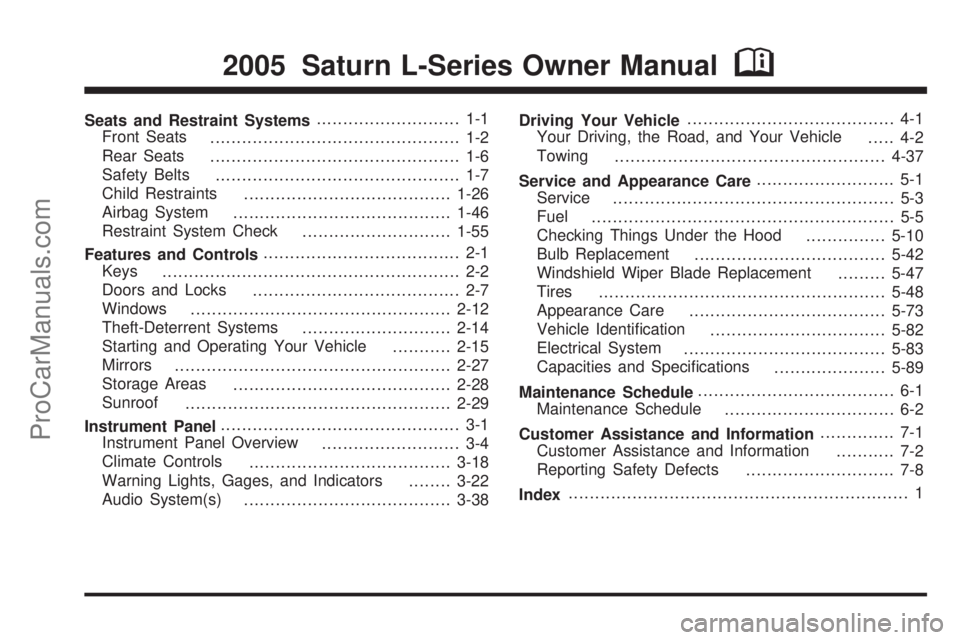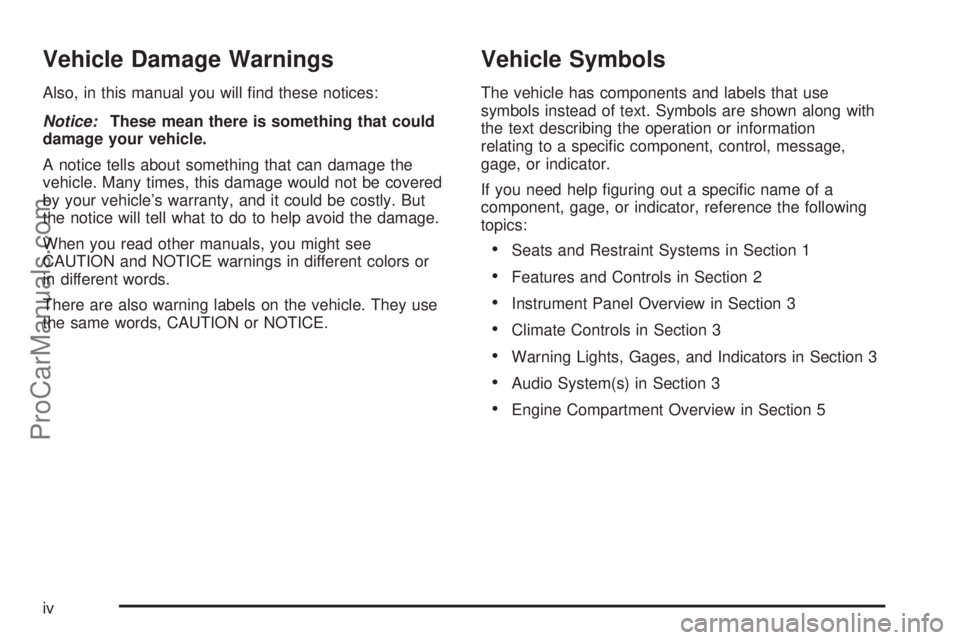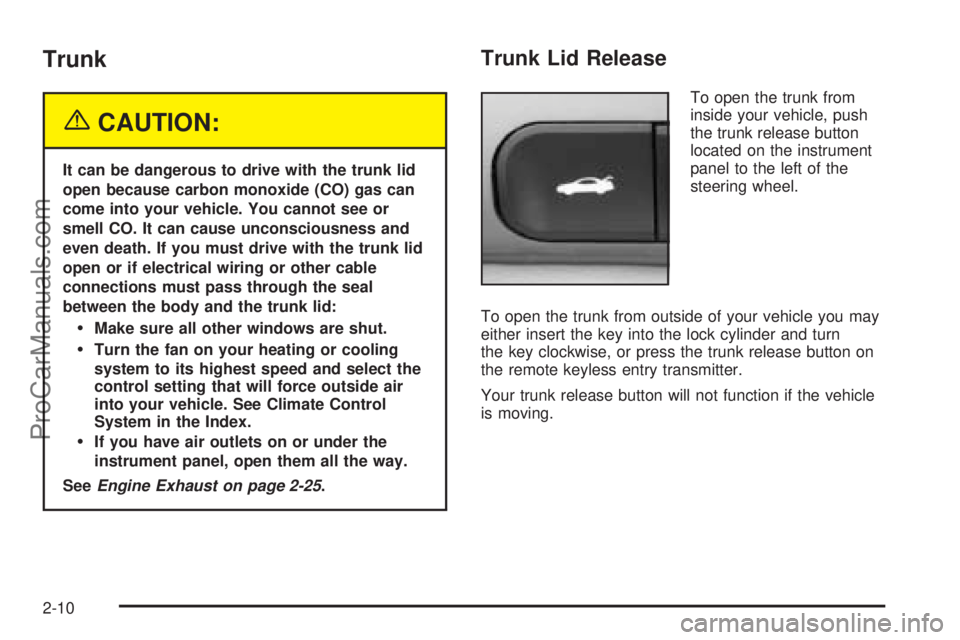climate control SATURN L-SERIES 2005 Owners Manual
[x] Cancel search | Manufacturer: SATURN, Model Year: 2005, Model line: L-SERIES, Model: SATURN L-SERIES 2005Pages: 330, PDF Size: 2.4 MB
Page 1 of 330

Seats and Restraint Systems........................... 1-1
Front Seats
............................................... 1-2
Rear Seats
............................................... 1-6
Safety Belts
.............................................. 1-7
Child Restraints
.......................................1-26
Airbag System
.........................................1-46
Restraint System Check
............................1-55
Features and Controls..................................... 2-1
Keys
........................................................ 2-2
Doors and Locks
....................................... 2-7
Windows
.................................................2-12
Theft-Deterrent Systems
............................2-14
Starting and Operating Your Vehicle
...........2-15
Mirrors
....................................................2-27
Storage Areas
.........................................2-28
Sunroof
..................................................2-29
Instrument Panel............................................. 3-1
Instrument Panel Overview
.......................... 3-4
Climate Controls
......................................3-18
Warning Lights, Gages, and Indicators
........3-22
Audio System(s)
.......................................3-38Driving Your Vehicle....................................... 4-1
Your Driving, the Road, and Your Vehicle
..... 4-2
Towing
...................................................4-37
Service and Appearance Care.......................... 5-1
Service
..................................................... 5-3
Fuel
......................................................... 5-5
Checking Things Under the Hood
...............5-10
Bulb Replacement
....................................5-42
Windshield Wiper Blade Replacement
.........5-47
Tires
......................................................5-48
Appearance Care
.....................................5-73
Vehicle Identification
.................................5-82
Electrical System
......................................5-83
Capacities and Specifications
.....................5-89
Maintenance Schedule..................................... 6-1
Maintenance Schedule
................................ 6-2
Customer Assistance and Information.............. 7-1
Customer Assistance and Information
........... 7-2
Reporting Safety Defects
............................ 7-8
Index................................................................ 1
2005 Saturn L-Series Owner ManualM
ProCarManuals.com
Page 4 of 330

Vehicle Damage Warnings
Also, in this manual you will find these notices:
Notice:These mean there is something that could
damage your vehicle.
A notice tells about something that can damage the
vehicle. Many times, this damage would not be covered
by your vehicle’s warranty, and it could be costly. But
the notice will tell what to do to help avoid the damage.
When you read other manuals, you might see
CAUTION and NOTICE warnings in different colors or
in different words.
There are also warning labels on the vehicle. They use
the same words, CAUTION or NOTICE.
Vehicle Symbols
The vehicle has components and labels that use
symbols instead of text. Symbols are shown along with
the text describing the operation or information
relating to a specific component, control, message,
gage, or indicator.
If you need help figuring out a specific name of a
component, gage, or indicator, reference the following
topics:
•Seats and Restraint Systems in Section 1
•Features and Controls in Section 2
•Instrument Panel Overview in Section 3
•Climate Controls in Section 3
•Warning Lights, Gages, and Indicators in Section 3
•Audio System(s) in Section 3
•Engine Compartment Overview in Section 5
iv
ProCarManuals.com
Page 72 of 330

Trunk
{CAUTION:
It can be dangerous to drive with the trunk lid
open because carbon monoxide (CO) gas can
come into your vehicle. You cannot see or
smell CO. It can cause unconsciousness and
even death. If you must drive with the trunk lid
open or if electrical wiring or other cable
connections must pass through the seal
between the body and the trunk lid:
Make sure all other windows are shut.
Turn the fan on your heating or cooling
system to its highest speed and select the
control setting that will force outside air
into your vehicle. See Climate Control
System in the Index.
If you have air outlets on or under the
instrument panel, open them all the way.
SeeEngine Exhaust on page 2-25.
Trunk Lid Release
To open the trunk from
inside your vehicle, push
the trunk release button
located on the instrument
panel to the left of the
steering wheel.
To open the trunk from outside of your vehicle you may
either insert the key into the lock cylinder and turn
the key clockwise, or press the trunk release button on
the remote keyless entry transmitter.
Your trunk release button will not function if the vehicle
is moving.
2-10
ProCarManuals.com
Page 88 of 330

Running Your Engine While You
Are Parked
It is better not to park with the engine running. But if
you ever have to, here are some things to know.
{CAUTION:
Idling the engine with the climate control
system off could allow dangerous exhaust into
your vehicle. See the earlier caution under
Engine Exhaust on page 2-25.
Also, idling in a closed-in place can let deadly
carbon monoxide (CO) into your vehicle even if
the climate control fan is at the highest setting.
One place this can happen is a garage.
Exhaust — with CO — can come in easily.
NEVER park in a garage with the engine
running.
Another closed-in place can be a blizzard.
SeeWinter Driving on page 4-26.
{CAUTION:
It can be dangerous to get out of your vehicle
if the shift lever is not fully in PARK (P) with
the parking brake �rmly set. Your vehicle can
roll. Do not leave your vehicle when the engine
is running unless you have to. If you have left
the engine running, the vehicle can move
suddenly. You or others could be injured. To
be sure your vehicle will not move, even when
you are on fairly level ground, always set your
parking brake and move the shift lever to
PARK (P).
Follow the proper steps to be sure your vehicle will not
move. SeeShifting Into Park (P) on page 2-23.
If you are parking on a hill and if you are pulling a
trailer, also seeTowing a Trailer on page 4-40.
2-26
ProCarManuals.com
Page 90 of 330

Outside Convex Mirror
{CAUTION:
A convex mirror can make things (like other
vehicles) look farther away than they really are.
If you cut too sharply into the right lane, you
could hit a vehicle on your right. Check your
inside mirror or glance over your shoulder
before changing lanes.
The passenger’s side mirror is convex. A convex
mirror’s surface is curved so more can be seen from
the driver’s seat. It also makes things appear farther
away than they really are.
Outside Heated Mirrors
When the rear window defogger is turned on, it also
warms both outside rearview mirrors to help clear them
of ice, snow, or condensation. SeeClimate Control
System on page 3-18.
Storage Areas
Glove Box
To open the glove box, lift up on the lever. The glove
box has a light inside.
Center Console Storage Area
Your vehicle is equipped with a center console.
To open the console’s storage area, pull up on the
latch located in the front of the console lid.
2-28
ProCarManuals.com
Page 93 of 330

Instrument Panel Overview...............................3-4
Hazard Warning Flashers................................3-6
Other Warning Devices...................................3-6
Horn.............................................................3-6
Tilt Wheel.....................................................3-6
Turn Signal/Multifunction Lever.........................3-7
Turn and Lane-Change Signals........................3-7
Headlamp High/Low-Beam Changer..................3-8
Flash-to-Pass.................................................3-8
Windshield Washer.........................................3-8
Windshield Wiper Lever...................................3-9
Cruise Control..............................................3-10
Headlamps..................................................3-13
Daytime Running Lamps (DRL).......................3-13
Automatic Headlamp System..........................3-14
Fog Lamps..................................................3-15
Instrument Panel Brightness...........................3-15
Dome Lamp.................................................3-16
Entry Lighting...............................................3-16
Map Lamps.................................................3-16
Battery Run-Down Protection..........................3-16
Accessory Power Outlets...............................3-16
Ashtrays and Cigarette Lighter........................3-17Climate Controls............................................3-18
Climate Control System.................................3-18
Outlet Adjustment.........................................3-20
Passenger Compartment Air Filter...................3-21
Warning Lights, Gages, and Indicators............3-22
Instrument Panel Cluster................................3-23
Speedometer and Odometer...........................3-24
Trip Odometer..............................................3-24
Tachometer.................................................3-25
Safety Belt Reminder Light.............................3-25
Airbag Readiness Light..................................3-26
Battery Warning Light....................................3-27
Brake System Warning Light..........................3-27
Anti-Lock Brake System Warning Light.............3-28
Traction Control System (TCS) Warning Light . . .3-29
Engine Coolant Temperature Warning Light......3-29
Engine Coolant Temperature Gage..................3-30
Low Coolant Warning Light............................3-30
Malfunction Indicator Lamp.............................3-31
Oil Pressure Light.........................................3-33
Change Engine Oil Light................................3-34
Security Light...............................................3-34
Section 3 Instrument Panel
3-1
ProCarManuals.com
Page 97 of 330

The main components of the instrument panel are the following:
A. Air Outlets. SeeOutlet Adjustment on page 3-20.
B. Turn Signal/Multifunction Lever. SeeTurn
Signal/Multifunction Lever on page 3-7.
C. Cruise Control. SeeCruise Control on page 3-10.
D. Horn. SeeHorn on page 3-6.
E. Instrument Panel Cluster. SeeInstrument Panel
Cluster on page 3-23.
F. Windshield Wiper Lever. SeeWindshield Wiper
Lever on page 3-9.
G. Fog Lamps (If Equipped). SeeFog Lamps on
page 3-15.
H. Hazard Warning Flasher Button. SeeHazard
Warning Flashers on page 3-6.I. Traction Control. SeeTraction Control System (TCS)
Warning Light on page 3-29.
J. Audio System. SeeAudio System(s) on page 3-38.
K. Trunk Release Button/Dimmer Switch. SeeTrunk
on page 2-10andInstrument Panel Brightness
on page 3-15.
L. Hood Release. SeeHood Release on page 5-11.
M. Climate Control. SeeClimate Control System
on page 3-18.
N. Automatic Transaxle Shift Lever. SeeAutomatic
Transaxle Operation on page 2-18.
O. Power Windows. SeePower Windows on page 2-13.
P. Glove Box. SeeGlove Box on page 2-28.
3-5
ProCarManuals.com
Page 110 of 330

Climate Controls
Climate Control System
With this system you can control the heating, cooling
and ventilation for your vehicle.
Operation
To change the current mode, turn the right knob to
select one of the following:
H(Vent):This mode directs air to the instrument
panel outlets.
)(Bi-Level):This mode directs half of the air to the
instrument panel outlets, and then directs most of
the remaining air to the floor outlets. Some air may be
directed toward the side windows.
6(Floor):This mode directs most of the air to the
floor outlets with some air directed to the side window
outlets.
The right knob can also be used to select defog or
defrost modes. Information on defogging and defrosting
can be found later in this section.
A(Fan):Turn the knob in the center of the system
clockwise or counterclockwise to increase or decrease
the fan speed. The fan must be on to run the
air-conditioning compressor.
Temperature Control:Turn the left knob clockwise or
counterclockwise to increase or decrease the
temperature inside your vehicle.
?(Recirculation):This mode keeps outside air
from coming in the vehicle. It can be used to prevent
outside air and odors from entering your vehicle or
to help cool the air inside your vehicle more quickly.
Press this button to turn the recirculation mode on or off.
When the button is pressed, an indicator light above
the button will come on to let you know that it is
activated. The air-conditioning compressor comes on.
3-18
ProCarManuals.com
Page 111 of 330

The recirculation mode can be used with vent, bi-level,
or floor modes, but it cannot be used with the defog
or defrost modes. When you switch to the defog
or defrost modes the system will automatically move
from recirculation to outside air. When you move
the mode knob back to another mode, the system will
move back into recirculation. When the car is turned off
and back on the system will default to outside air
automatically.
AC (Air Conditioning):Press this button to turn the
air-conditioning system on or off. When A/C is pressed,
an indicator light above the button will come on to let
you know that air conditioning is activated.
On hot days, open the windows to let hot inside air
escape; then close them. This helps to reduce the time
it takes for your vehicle to cool down. It also helps
the system to operate more efficiently.
For quick cool down on hot days, do the following:
1. Select the vent mode.
2. Select the highest fan speed.
3. Select A/C.
4. Select the recirculation mode.
5. Select the coolest temperature.Using these settings together for long periods of time
may cause the air inside of your vehicle to become too
dry. To prevent this from happening, after the air in
your vehicle has cooled, turn the recirculation mode off.
The air-conditioning system removes moisture from
the air, so you may sometimes notice a small amount of
water dripping underneath your vehicle while idling or
after turning off the engine. This is normal.
Defogging and Defrosting
Fog on the inside of windows is a result of high humidity
(moisture) condensing on the cool window glass. This
can be minimized if the climate control system is used
properly. There are two modes to choose from to clear
fog or frost from your windshield. Use the defog mode
to clear the windows of fog or moisture and warm the
passengers. Use the defrost mode to remove fog or frost
from the windshield more quickly.
Turn the right knob to select the defog or defrost mode.
-(Defog):This mode directs half of the air to the
windshield and half to the floor outlets with a small
amount directed to the side windows. When you select
this mode, the system turns off recirculation automatically
and runs the air-conditioning compressor unless the
outside temperature is at or below freezing. The
recirculation mode cannot be selected while in the
defog mode. Do not drive the vehicle until all the
windows are clear.
3-19
ProCarManuals.com
Page 113 of 330

Passenger Compartment Air Filter
Your vehicle may be equipped with a passenger
compartment air filter. It is located underneath the hood
just below the windshield wiper arm on the passenger’s
side of the vehicle.
The filter traps most of the pollen from air entering the
Climate Control System. Like your engine’s air
cleaner/filter, it may need to be changed periodically to
insure system performance. For information on how
often to change the passenger compartment air
filter, seeScheduled Maintenance on page 6-4.
For the type of filter to use, seeNormal Maintenance
Replacement Parts on page 6-14.
To change the passenger compartment air filter, use the
following steps:
1. Open the hood. Locate the passenger compartment
air filer access panel.
2. Peel back the hood weatherstrip from the
passenger’s side of the vehicle halfway to center.3. Use a tool to open the passenger compartment
air filter access door.
4. Remove any leaves or other debris from the
filter area.
3-21
ProCarManuals.com